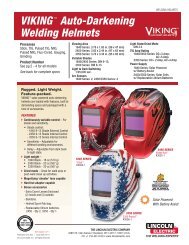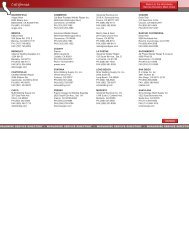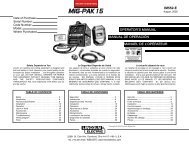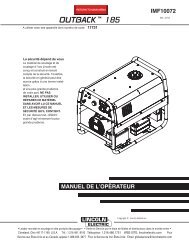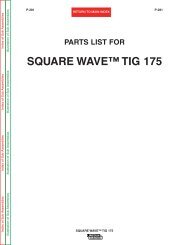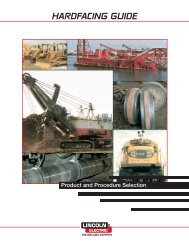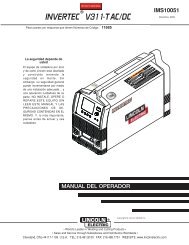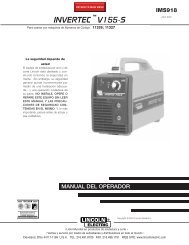Innershield Welding Guide (pdf) - Lincoln Electric
Innershield Welding Guide (pdf) - Lincoln Electric
Innershield Welding Guide (pdf) - Lincoln Electric
You also want an ePaper? Increase the reach of your titles
YUMPU automatically turns print PDFs into web optimized ePapers that Google loves.
WELDING TECHNIQUES<br />
Vertical Up Fillet and Lap Welds<br />
1. Make larger welds with the following techniques:<br />
a. On 1/4” (6mm) welds, a short side-to-side motion is<br />
usually sufficient.<br />
b. On larger welds, use a triangular weave (see number<br />
1 in the sketch below) with a distinct hesitation at the<br />
outer edges for the first pass.<br />
c. Use a side-to-side weave (see number 2 in the sketch<br />
below) similar to that used for butt welds on the<br />
second and later passes. The first pass should have a<br />
face width of 5/16” - 3/8” (8 - 10mm) before<br />
starting this weave.<br />
2<br />
MAKING DOWNHILL AND VERTICAL DOWN WELDS<br />
With NR-202, NR-203 (types), NR-207, NR-208-H,<br />
NR-211-MP, NR-212<br />
Make 1/4” (6mm) or smaller welds using vertical down techniques.<br />
The excellent high speed welding characteristics are best utilized<br />
for low cost single pass welds by positioning the work downhill or<br />
vertical down. About a 60° downhill angle with 5/64” or 3/32” (2.0<br />
or 2.4mm) electrode usually provides maximum speed.<br />
Use stringer beads and currents in the middle to high portion of<br />
the range. Tip the electrode up so that arc force helps hold the<br />
molten metal in the joint. Move as fast as possible consistent with<br />
desired bead shape.<br />
10-15°<br />
– 23 –<br />
1



